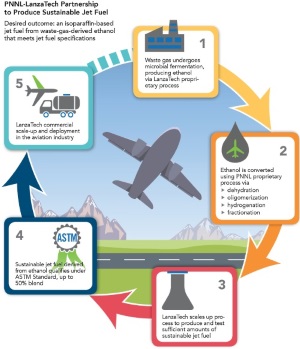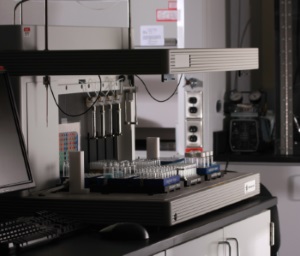
Effective Use of Renewable Electricity for Making Renewable Fuels and Chemicals
by Bob Weber

The increasing availability of renewably generated electricity could change the way that chemicals and fuels are manufactured by substituting conventional, thermally activated processes with possibly more selective and certainly more highly distributable electrochemically activated processes. Renewable electricity, however, is not free electricity. Converting carbon dioxide back into a fuel, say methane, requires adding energy equal to or greater than the heat of combustion of the fuel. Read more.
Sustainable Jet Fuel: The Flight Path from Fundamental Science to Applied Technology
By Andrea McMakin

Through chemistry, catalysis, and engineering that started at Pacific Northwest National Laboratory and was scaled up by LanzaTech, the aviation industry now has a way to make sustainable fuel blends that meet the jet fuel standards and are more cost-competitive than ever. Learn about the journey from idea to jet fuel as researchers found a way to create energy-dense fuel from waste-derived ethanol. Read more.
Embracing Complexity and Chaos: Roger Rousseau
An expansive, realistic attitude to molecular theory garners novel findings, talented cadre of scientists
 What you see in the details says something about your personality and your job. For those who create and use computer models to understand the fundamental laws of the universe, details are what ground models in reality. By creating models that reflect the complex nature of the situation, Roger Rousseau has pushed state-of-the-art theory into solving increasingly harder problems. Read more.
What you see in the details says something about your personality and your job. For those who create and use computer models to understand the fundamental laws of the universe, details are what ground models in reality. By creating models that reflect the complex nature of the situation, Roger Rousseau has pushed state-of-the-art theory into solving increasingly harder problems. Read more.
Capability Corner: High Throughput Center
Heather Job

Developing and fine tuning a novel catalyst can be daunting. Instead of synthesizing and testing one catalyst at a time, hundreds of catalysts are quickly evaluated in the High Throughput Center at Pacific Northwest National Laboratory. With the help of specialized robotics, several dozen unique catalyst materials are synthesized and tested in parallel. The key to this speedy screening is size. Traditionally catalysts are developed is done on a 50- to 500-gram scale. The center operates on a 50-milligram scale. Read more.
Summer 2018
Catalysis News
Two New State Academy Members. Morris Bullock and Yuehe Lin were elected to the Washington State Academy of Sciences.
Center for Molecular Electrocatalysis Renewed. The Department of Energy renewed funding for the center that explores scientific principles which underpin solar energy and fuel cells. The researchers earned the renewal through their achievements in developing catalysts that can convert energy between electrical and chemical forms.
Make a Splash: Duo Reviews How Liquids Alter Energy-Storing Reactions. Sunlight, water, and carbon dioxide could be used to create fuel, but the role of the solvent was often overlooked. Eric Wiedner and John Linehan are correcting that oversight in their invited article.
Invited Article Reviews the State of Fuel Production from Waste Carbon. In their article, Robert (Bob) S. Weber, Johnathan Holladay, Ellen Panisko, Lesley Snowden-Swan (all PNNL), and their colleagues estimate that now-wasted carbon can be converted into a fuel precursor that equates to about 420 million barrels of petroleum a year.
Joint Appointment Recognized by American Chemical Society. Yong Wang was honored with the Society's annual Industrial and Engineering Chemistry Division Fellow Award.
Pacific Northwest National Laboratory is the nation's premier laboratory for scientific discovery in chemistry, earth sciences, and data analytics and for solutions to the nation's toughest challenges in energy resiliency and national security. Founded in 1965, PNNL is operated by Battelle for the U.S. Department of Energy's Office of Science. DOE's Office of Science is the single largest supporter of basic research in the physical sciences in the United States, and is working to address some of the most pressing challenges of our time. For more information on PNNL, visit the PNNL News Center, or follow PNNL on Facebook, Google+, LinkedIn and Twitter.
EMSL, the Environmental Molecular Sciences Laboratory, is a DOE Office of Science user facility. Located at Pacific Northwest National Laboratory in Richland, Wash., EMSL offers an open, collaborative environment for scientific discovery to researchers around the world. Its integrated computational and experimental resources enable researchers to realize important scientific insights and create new technologies.
If you have feedback – ideas, suggestions or questions – about IIC's Transformations, please contact Kristin Manke.